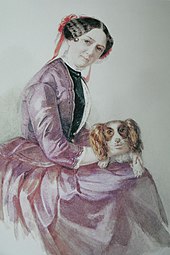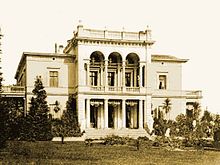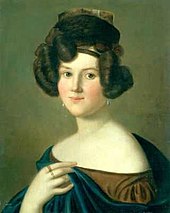Minna Wagner
Wilhelmine "Minna" Wagner , b. Planer (born September 5, 1809 in Oederan , † January 25, 1866 in Dresden ), was a German actress and the first wife of Richard Wagner , with whom she was married for about 30 years.
Life

The first years with Richard Wagner
Richard Wagner met the attractive, four years older Minna Planer in Bad Lauchstädt in 1834 when he became music director of the Bethmann theater company for a short time, in which she was one of the leading actresses. The Bethmannsche Troupe from Magdeburg made a guest appearance in the summer of 1834 in the Kurtheater zu Lauchstädt, today's Goethe Theater. Minna was raped at the age of 15 and had an illegitimate daughter whom she passed off as her younger sister Natalie. She married 23-year-old Richard Wagner in November 1836 in the Tragheim Church in Königsberg , where Minna had found a job at the theater. A little later, the couple moved to Riga , where Richard Wagner took up a position as music director.
Because of Wagner's exalted lifestyle, there was a lot of argument in the marriage. Minna entered into a secret love affair with a merchant named Dietrich and left Wagner at the end of May 1837, but returned to him in October. It was a traumatic experience for Wagner, which he was to mirror in his next opera The Flying Dutchman , which is about the redeeming eternal loyalty of a woman who wavers between two men. Finally, in the summer of 1839, both had to flee from the creditors of Riga and reached London and Paris via the Baltic and North Seas. In Paris they lived in extremely modest circumstances, with Wagner trying to keep his head above water through musical and literary contract work because he could not perform his newly composed opera Rienzi in Paris. In 1842 he managed to get a job in Dresden and to establish himself there. The world premiere of his Rienzi brought an initial great success that made Wagner well known. A few months later, his Flying Dutchman was premiered in Dresden, and Wagner was then appointed Royal Saxon Court Kapellmeister. Minna flourished here and was an indispensable helper for Wagner, so that he was able to fulfill his function as court conductor and free composer (he composed Tannhäuser and Lohengrin in Dresden ).
In Dresden and Zurich
Because of her husband's political activities and his friendship with August Röckel and Michail Bakunin , there were repeated arguments from 1847 onwards, which then escalated when Wagner had to flee into exile in Zurich because of his involvement in the Dresden May Uprising in 1849 . Both lost all privileges. There was a very emotional exchange of letters in which Wagner asked his wife for understanding that she would only work as an artist in the future and begged her to follow him. Minna was skeptical and wrote, among other things:
- “I must honestly confess to you, dear Richard, that this time it is very difficult for me to part with my homeland; will I ever see her again? God knows! I find it difficult to get used to strangers, you are happier than I am, something new attracts you much more, but it can hardly be possible that you will be honored and adored more in Zurich than it was in Dresden at the beginning . But you mustn't misinterpret it to me if I'm worried about our existence, because I can't experience again what I already endured with you. My greatest pride and pleasure was undeniably to see you at the head of the most important band in all of Germany. You will remember that I almost never missed a performance that you conducted, I only saw you and was happy! You will make the ninth symphony forever unforgettable. You appeared to me like a god who ruled all powerful elements and charmed people. Dear Richard, you have the strength, the wonderful gift of creating great things as a conductor. "
Minna eventually moved to Zurich with her daughter, where they again lived under modest circumstances. Just a few months later, on the occasion of Wagner's affair with Jessie Laussot (née Taylor), who was married to a wealthy wine merchant in Bordeaux , tensions rose again. They did find each other again, but lived in “different worlds”, as Wagner wrote to his friend Franz Liszt in 1854 : “None of the last years of my life has passed me by without my being at the extreme end of my decision, mine To put an end to life. Everything is so lost in it! Through a premature marriage in the 23rd year of age with a respectable, but completely inappropriate woman, I became an ostracized for life. Verily, I lived until my 36th year, before I became completely aware of that terrible wasteland. Until then, my being was maintained through the balance of two conflicting elements of desire within me, one of which I tried to satisfy through my art, while I gave the other some air through hot, fantastic, sensual excesses from time to time! "
The break and the last few years
A few years later, Wagner was working on his Ring des Nibelungen and on Tristan and Isolde , the final break occurred in the summer of 1858. Because of the ever more intense friendship with Mathilde Wesendonck , who Wagner saw as his muse, Minna let it come to a scandal, as a result of which Wagner left Zurich and traveled to Venice to settle there and continue to work on Tristan , while Minna to hers Relatives moved to Dresden.


When Wagner settled again in Paris in 1860, financed by a generous fee from Otto Wesendonck , his wife came back to him again. Together they experienced the “ Tannhäuser scandal” in the Paris Opera, a reactionary audience that was forced to withdraw his opera Tannhäuser by disrupting the performances . Without a future together, they parted again. Minna, who was now suffering from heart disease, traveled several times to Bad Soden for a cure , and later back to Dresden. In February 1862 there was a last personal encounter when Wagner was working on his Mastersingers in Wiesbaden-Biebrich . After only ten days, however, they separated again, realizing the hopelessness of ever living amicably together again.
Despite his tight financial circumstances, Wagner continued to pay for them throughout his life. Minna set up "a little room" for him in Dresden in the hope that everything could turn out well again. But Wagner fell in love with Cosima von Bülow , with whom he soon lived in Munich and later, after Minna's death, in Tribschen near Lucerne. After he had made a small fortune with the help of King Ludwig II of Bavaria , he transferred a large amount of money to Minna so that she could lead a modest life. In one of her last letters, which she wrote to her old friend Ernst Benedikt Kietz , she summed up:
- “My life here would be quite bearable if I hadn't lost my health more and more as a result of the grief Richard inflicted on me so unscrupulously. My friends have all remained loyal to me, are kind and good to me, which is like heavenly balm in my sore heart. I haven't seen my good, excellent husband for nearly two and a half years. - He's happy, he doesn't need me anymore. If he were then in great misery again, he would come back to me. - God knows if I will experience this and when. Would I still be in such a mood, a man who offended me so deeply and continuously and this out of exaggerated, silly vanity which awakened the wretched, dissolute women in him, whereby he became heartless and angry with his stupid, faithful partner. Unfortunately, he is going under as an artist, because since he separated from me, he has not created anything, his whole life dissolves into absurd, unworthy external wretchedness. What a shame to see a man so richly gifted by God stop creating in his prime, when he was still able to make the world happy with many wonderful works, the most beautiful works in a sensible, regulated life, so to speak from the Shook sleeves. These beautiful times are just as unlikely to come as the younger years. "
Minna died on January 25, 1866 from complications from her long-term heart disease. Her grave is in the old Annenfriedhof in Dresden, grave field L, a few meters away from the grave of the artist family Julius , Ludwig and Malvina Schnorr von Carolsfeld, who are friends of theirs .
effect
Minna Wagner was considered charming and more "domestic". In the first phase of Wagner's life she was his support, less in the artistic but more in everyday matters. Minna Wagner's correspondence (over 100 letters) was later published by her daughter Natalie (later Bilz-Planer) in the " Mary Burrell " collection of letters , an English Wagner admirer. They are of great importance for Wagner research because they also contain information about the genesis of Wagner's works, e.g. B. The Ring of the Nibelung .
See also
Individual evidence
- ^ Eva Rieger: Minna Wagner - the first wife of Richard Wagner , MDR TV, January 15, 2015, accessed on February 8, 2015
literature
- John N. Burk (Ed.): Richard Wagner letters. The Burrell Collection. Fischer, Frankfurt 1950.
- Sven Friedrich (Ed.): Richard Wagner; Works, writings and letters. Digital library. Directmedia, Berlin 2004.
- Martin Gregor-Dellin (Ed.): Richard Wagner - My life. List, Munich 1994, ISBN 3-471-79153-1 .
- Friedrich Herzfeld : Minna Planer and her marriage to Richard Wagner. Goldmann, Leipzig 1938.
- Hanjo Kesting (ed.): Richard Wagner - letters. Piper, Munich 1983, ISBN 3-492-02829-2 .
- Werner Markgraf: Where Richard Wagner's first wife was born. In: Erzgebirgische Heimatblätter . 5/2009, ISSN 0232-6078 , p. 30.
- Eva Rieger: Minna and Richard Wagner, stages of love. Artemis & Winkler, Düsseldorf / Zurich 2003, ISBN 3-538-07154-3 .
- Sibylle Zehle: Minna Wagner, a search for clues. Hoffmann and Campe, Hamburg 2004, ISBN 3-455-09439-2
Web links
- Minna Wagner in the database of Find a Grave (English)
| personal data | |
|---|---|
| SURNAME | Wagner, Minna |
| ALTERNATIVE NAMES | Wagner, Wilhelmine; Planner, Minna (maiden name) |
| BRIEF DESCRIPTION | German actress, first wife of Richard Wagner |
| DATE OF BIRTH | September 5, 1809 |
| PLACE OF BIRTH | Oederan |
| DATE OF DEATH | January 25, 1866 |
| Place of death | Dresden |

